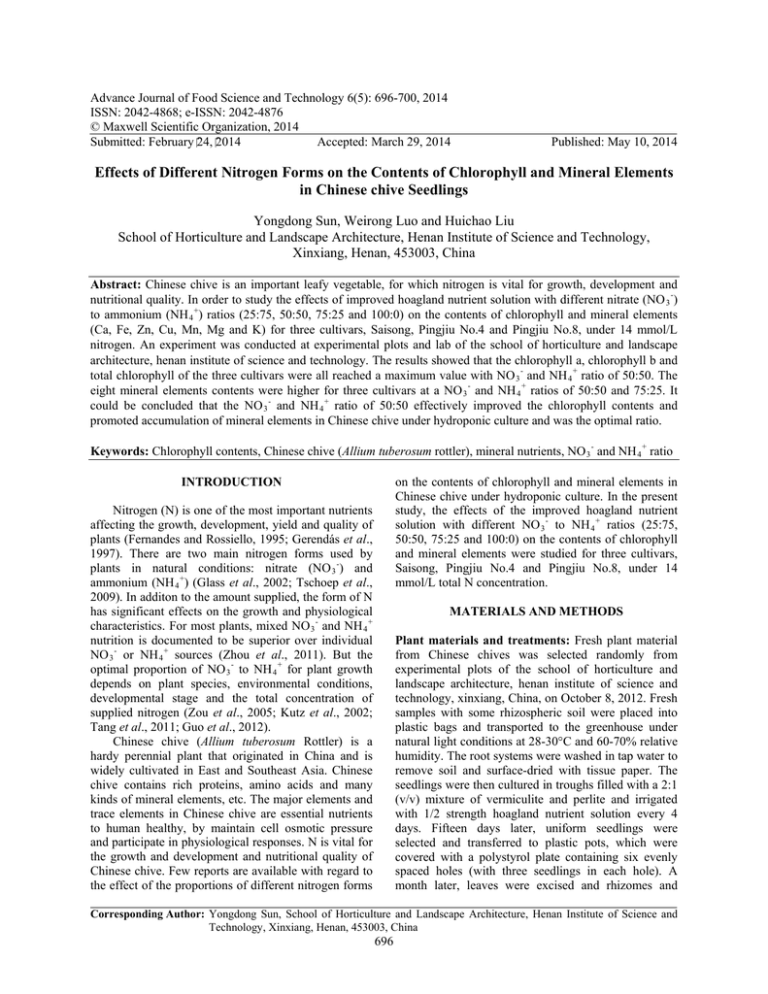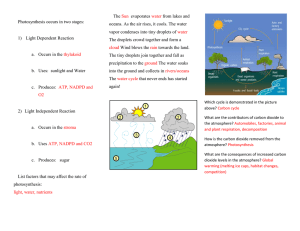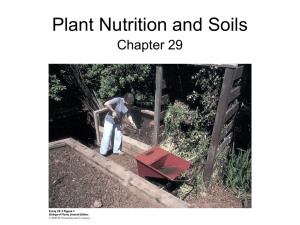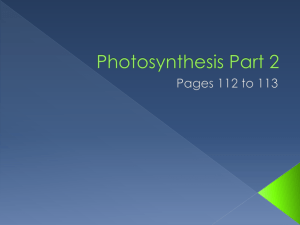Advance Journal of Food Science and Technology 6(5): 696-700, 2014
advertisement

Advance Journal of Food Science and Technology 6(5): 696-700, 2014 ISSN: 2042-4868; e-ISSN: 2042-4876 © Maxwell Scientific Organization, 2014 Submitted: February 24, 2014 Accepted: March 29, 2014 Published: May 10, 2014 Effects of Different Nitrogen Forms on the Contents of Chlorophyll and Mineral Elements in Chinese chive Seedlings Yongdong Sun, Weirong Luo and Huichao Liu School of Horticulture and Landscape Architecture, Henan Institute of Science and Technology, Xinxiang, Henan, 453003, China Abstract: Chinese chive is an important leafy vegetable, for which nitrogen is vital for growth, development and nutritional quality. In order to study the effects of improved hoagland nutrient solution with different nitrate (NO 3 -) to ammonium (NH 4 +) ratios (25:75, 50:50, 75:25 and 100:0) on the contents of chlorophyll and mineral elements (Ca, Fe, Zn, Cu, Mn, Mg and K) for three cultivars, Saisong, Pingjiu No.4 and Pingjiu No.8, under 14 mmol/L nitrogen. An experiment was conducted at experimental plots and lab of the school of horticulture and landscape architecture, henan institute of science and technology. The results showed that the chlorophyll a, chlorophyll b and total chlorophyll of the three cultivars were all reached a maximum value with NO 3 - and NH 4 + ratio of 50:50. The eight mineral elements contents were higher for three cultivars at a NO 3 - and NH 4 + ratios of 50:50 and 75:25. It could be concluded that the NO 3 - and NH 4 + ratio of 50:50 effectively improved the chlorophyll contents and promoted accumulation of mineral elements in Chinese chive under hydroponic culture and was the optimal ratio. Keywords: Chlorophyll contents, Chinese chive (Allium tuberosum rottler), mineral nutrients, NO 3 - and NH 4 + ratio on the contents of chlorophyll and mineral elements in Chinese chive under hydroponic culture. In the present study, the effects of the improved hoagland nutrient solution with different NO 3 - to NH 4 + ratios (25:75, 50:50, 75:25 and 100:0) on the contents of chlorophyll and mineral elements were studied for three cultivars, Saisong, Pingjiu No.4 and Pingjiu No.8, under 14 mmol/L total N concentration. INTRODUCTION Nitrogen (N) is one of the most important nutrients affecting the growth, development, yield and quality of plants (Fernandes and Rossiello, 1995; Gerendás et al., 1997). There are two main nitrogen forms used by plants in natural conditions: nitrate (NO 3 -) and ammonium (NH 4 +) (Glass et al., 2002; Tschoep et al., 2009). In additon to the amount supplied, the form of N has significant effects on the growth and physiological characteristics. For most plants, mixed NO 3 - and NH 4 + nutrition is documented to be superior over individual NO 3 - or NH 4 + sources (Zhou et al., 2011). But the optimal proportion of NO 3 - to NH 4 + for plant growth depends on plant species, environmental conditions, developmental stage and the total concentration of supplied nitrogen (Zou et al., 2005; Kutz et al., 2002; Tang et al., 2011; Guo et al., 2012). Chinese chive (Allium tuberosum Rottler) is a hardy perennial plant that originated in China and is widely cultivated in East and Southeast Asia. Chinese chive contains rich proteins, amino acids and many kinds of mineral elements, etc. The major elements and trace elements in Chinese chive are essential nutrients to human healthy, by maintain cell osmotic pressure and participate in physiological responses. N is vital for the growth and development and nutritional quality of Chinese chive. Few reports are available with regard to the effect of the proportions of different nitrogen forms MATERIALS AND METHODS Plant materials and treatments: Fresh plant material from Chinese chives was selected randomly from experimental plots of the school of horticulture and landscape architecture, henan institute of science and technology, xinxiang, China, on October 8, 2012. Fresh samples with some rhizospheric soil were placed into plastic bags and transported to the greenhouse under natural light conditions at 28-30°C and 60-70% relative humidity. The root systems were washed in tap water to remove soil and surface-dried with tissue paper. The seedlings were then cultured in troughs filled with a 2:1 (v/v) mixture of vermiculite and perlite and irrigated with 1/2 strength hoagland nutrient solution every 4 days. Fifteen days later, uniform seedlings were selected and transferred to plastic pots, which were covered with a polystyrol plate containing six evenly spaced holes (with three seedlings in each hole). A month later, leaves were excised and rhizomes and Corresponding Author: Yongdong Sun, School of Horticulture and Landscape Architecture, Henan Institute of Science and Technology, Xinxiang, Henan, 453003, China 696 Adv. J. Food Sci. Technol., 6(5): 696-700, 2014 Table 1: Components of macroelements in the nutrition solution under different treatments NO 3 -: Ca(NO 3 ) 2 KNO 3 MgSO 4 NH 4 H 2 PO 4 KH 2 PO 4 Treatments NH 4 + (mmol/L) (mmol/L) (mmol/L) (mmol/L) (mmol/L) T1 25:75 1.8 0.0 2 1 0 T2 50:50 3.6 0.0 2 1 0 T3 75:25 2.7 5.4 2 1 0 T4 100:0 4.3 5.7 2 0 1 KCl (mmol/L) 7.7 7.7 2.3 1 NH 4 Cl (mmol/L) 9.7 6.1 2.5 0 CaCl 2 (mmol/L) 2.4 0.7 1.5 0 roots were placed in troughs and supplied with fullstrength hoagl and nutrient solution containing NO 3 and NH 4 + at one of four ratios. The composition of the macroelements in the nutrition solution under different treatments is shown in Table 1. The composition of micronutrients (in µmol/L: 140 H 3 BO 3 , 100 CuSO 4 ·5H 2 O, 36 MnCl 2 ·4H 2 O, 46 ZnSO 4 ·7H 2 O, 30 Fe-EDTA and 1 H 2 MoO 2 ) were the same in all nutrient solutions. The total N concentration in both systems was 14 mmol/L. All treatments were conducted with three replicates. Chlorophyll contents measurements: Chlorophyll contents were determined in 80% acetone extract. After centrifugation (20,000 g, 20 min), the contents of chlorophyll a, chlorophyll b, total chlorophyll were analyzed spectrophotometrically using a TU1810 spectrophotometer (Puxi, Beijing, China), according to the method of Zhang and Qu (2003). Mineral concentrations measurements: Eighteen days later, Chinese chive leaves were excised randomly, rinsed in deionized water and blotted carefully with tissue paper. Then, they were dried at 105°C less than 30 min and dried at 85°C in a drying cabinet with air circulation until they reached constant weight. Later, they were grinded to a fine powder. About 0.5 g dried sample was digested by using 10ml HNO 3 and 1 mL H 2 O 2 in a closed microwave system. The volumes of the digested samples were completed to 20 mL with ultra-deionized water and mineral concentrations were determined inductively by coupled plasma–atomic emission spectroscopy (ICP-AES). Statistical analysis: All data were subjected to Analysis of Variance (ANOVA) using the SPSS version 10.0 statistical packages for Windows. Where the F-test showed significant differences among means, Duncan’s multiple range tests were applied at the 0.05 level of probability to separate means. Fig. 1: Effects of different NO 3 - to NH 4 +ratios on chlorophyll contents, A: chlorophyll a; B: chlorophyll b; C: total chlorophyll; T1: NO 3 - to NH 4 + ratio of 25:75; T2: NO 3 - to NH 4 + ratio of 50:50; T3: NO 3 - to NH 4 + ratio of 75:25; T4: NO 3 - to NH 4 + ratio of 100:0; the same explanation was used throughout this study RESULTS Chlorophyll contents: Different nitrogen forms significantly affected the chlorophyll contents of the three cultivars (Fig. 1). The chlorophyll a, chlorophyll b and total chlorophyll of the three cultivars were all reached a maximum value with T2 nitrogen solution. With T2 nitrogen solution, total chlorophyll was 0.58 mg/g in Saisong, 0.60 mg/g in Pingjiu No.4 and 0.54 mg/g in Pingjiu No.8, respectively. Ca, Fe and Zn contents: To assess the effect of different nitrogen forms on the accumulation of Ca, Fe, Zn, we compared their levels in the leaves when plants were incubated in solutions with different NO 3 - to NH 4 + ratios (Fig. 2). The T2 nitrogen solution greatly promoted the accumulation of Ca, Fe, Zn in Saisong and Pingjiu No.4 and the leaves had the highest Ca, Fe, 697 Adv. J. Food Sci. Technol., 6(5): 696-700, 2014 Fig. 2: Effects of different NO 3 - to NH 4 +ratios on Ca, Fe and Zn contents, A: Ca content; B: Fe content; C: Zn content; T1-T4 see Fig. 1 Fig. 3: Effects of different NO 3 - to NH 4 +ratios on Cu and Mn contents, A: Cu content; B: Mn content; T1-T4 see Fig. 1 Fig. 4: Effects of different NO 3 - to NH 4 +ratios on Mg and K contents, A: Mg content; B: K content; T1-T4 see Fig. 1 Zn contents. While, the T3 nitrogen solution increased Ca, Fe, Zn contents in Pingjiu No.8. their maximum values in T2, respectively. With T2 nitrogen solution, the Cu and Mn contents were 68.88 µg/g and 16.88 µg/g in Saisong, 57.88 µg/g and 15.75 µg/g in Pingjiu No.4 and 42.63 µg/g and 12.01 µg/g in Pingjiu No.8. Cu and Mn contents: Different nitrogen forms resulted in obvious changes in Cu and Mn contents (Fig. 3). Cu and Mn contents in the leaves of Saisong, Pingjiu No.4 and Pingjiu No.8 were all significantly enhanced in T2 and T3 nitrogen solutions and reached Mg content: The effects of different nitrogen forms on Mg content were shown in Fig. 4. Different NO 3 - to 698 Adv. J. Food Sci. Technol., 6(5): 696-700, 2014 NH 4 + ratios significantly affected the Mg contents of the three cultivars. Mg contents in the leaves of Saisong and Pingjiu No.8 both reached their maximum value in T3 nitrogen solution, which were 1412.50 µg/g and 1508.75 µg/g. Whereas Mg content of Pingjiu No.4 reached a maximum value in T2 nitrogen solution, which was 1467.50 µg/g. ACKNOWLEDGMENT This research was supported by Key Scientific and Technology Research Plan of Henan Province (No.132102110030) and Henan Province Young Teacher Plan (No.2012GGJS-141). REFERENCES K content: K contents were higher in leaves of the three cultivars treated with T3 and T4 nitrogen solutions and reached their maximum level in T3 nitrogen solutions, which were 18.2 mg/g in Saisong, 22.16 mg/g in Pingjiu No.4 and 25.66 mg/g in Pingjiu No.8, respectively (Fig. 4). Asada, K., 1999. The water-water cycle in chloroplasts: scavenging of active oxygen and dissipation of excess photons. Annu. Rev. Plant. Phys., 50: 601-639. Beale, S.I., 1999. Enzymes of chlorophyll biosynthesis. Photosynth. Res., 60: 43-73. Brody, T., 1994. Nutritional Biochemistry. Academic Press, San Diego, USA. Chen, L., Y.L. Zhu, L.F. Yang, G.C.H. Zhang, G.H. Chen and L.F. Chen, 2010. Effects of nitrogen forms and ratios on the contents of mineral nutrients in vegetable soybean seeds. Acta Agr. Boreali-Occident. Sin., 19(10): 189-193. Fernandes, M.S. and R.O.P. Rossiello, 1995. Mineral nitrogen in plant physiology and plant nutrition. Crit. Rev. Plant Sci., 14(2): 111-148. Gerendás, J., Z.J. Zhu, R. Bendixen, R.G. Ratcliffe and B. Sattelmacher, 1997. Physiological and biochemical processes related to ammonium toxicity in higher plants. Z. Pflanz. Bodenkunde., 160(2): 239-251. Glass, A.D., D.T. Britto, B.N. Kaiser, J.R. Kinghorn, H.J. Kronzucker, A. Kumar, M. Okamoto, S. Rawat, M.Y. Siddiqi, S.E. Unkles and J.J. Vidmar, 2002. The regulation of nitrate and ammonium transport systems in plants. J. Exp. Bot., 53: 855-864. Guo, X.R., Y.G. Zu and Z.H. Tang, 2012. Physiological responses of Catharanthus roseus to different nitrogen forms. Acta Physiol. Plant., 34: 589-598. Kaftan, D., V. Brumfeld, R. Nevo, A. Scherz and Z. Reich, 2002. From chloroplasts to photosystems: In situ scanning force microscopy on intact thylakoid membranes. Embo. J., 21: 6246-6253. Kutz, A., A. Müller, P. Hennig, W.M. Kaiser, M. Piotrowski and E.W. Weiler, 2002. A role for nitrilase in the regulation of root morphology in sulphur-starving Arabidopsis thaliana. Plant. J., 30: 95-106. Tang, Z.H., Y.J. Liu, X.R. Guo and Y.G. Zu, 2011. The combined effects of salinity and nitrogen forms on Catharanthus roseus: The role of internal ammonium and free amino acids during salt stress. J. Plant. Nutr. Soil. Sci., 174: 135-144. Tschoep, H., Y. Gibon, P. Carillo, P. Armengaud, M. Szecowka, A. Nunes-Nesi, A.R. Fernie, K. Koehl and M. Stitt, 2009. Adjustment of growth and central metabolism to a mild but sustained nitrogenlimitation in Arabidopsis. Plant. Cell. Environ., 32: 300-318. DISCUSSION AND CONCLUSION Previous study demonstrated that optimum of NO 3 to NH 4 + ratio can regulate plant growth by affecting the chlorophyll contents and accumulation of mineral elements etc. For example, Zhong et al. (2012) reported that NO 3 - and NH 4 + ratio of 30:70 improved the chlorophyll contents of Chinese kale. In the present study, the chlorophyll a, chlorophyll b and total chlorophyll of the three cultivars were all reached a maximum value with NO 3 - and NH 4 + ratio of 50:50. Mineral elements such as Ca, Fe, Zn, Cu, Mn, Mg and K are the active ingredients in plants and essential nutrients in human body growth. For example, Ca is the major component of bone and assists in teeth development (Brody, 1994). Fe is the important component of enzymes and proteins in plants, which is always considered in relation to the nitrogen fixation and photosynthesis. Zn, Cu and Mn involve the biochemical and physiological processes, as the the cofactors of SOD activity (Asada, 1999). As the central element in chlorophyll, Mg is essential for chloroplasts (Beale, 1999) and participates in thylakoid membrane organization and grana stacking, acts as a cofactor and allosteric activator of enzymes (Kaftan et al., 2002). K is the crucial substance in keeping electrolyte balance and deficiency in which, can lead to nausea, vomiting, abdominal distension, palpitation and arrhythmia etc (Zhang, 2009). Chen et al. (2010) reported that NO 3 - to NH 4 + ratios of (75:25, 50:50) in the nutrient solution greatly promoted the accumulation of Ca, Mg and K contents in developing seeds of vegetable soybean, but the excessive NH 4 + was harmful to the uptake of mineral elements. In this study, the eight mineral elements contents were higher for three cultivars at a NO 3 - and NH 4 + ratios of 50:50 and 75:25. In conclusion, the NO 3 - and NH 4 + ratio of 50:50 effectively improved the chlorophyll contents and promoted accumulation of mineral elements in Chinese chive under hydroponic culture and were the optimal ratio. 699 Adv. J. Food Sci. Technol., 6(5): 696-700, 2014 Zhang, H.Z., 2009. Clinical Biochemistry. People’s Health Press, Beijing, China. Zhang, Z.L. and W.Q. Qu, 2003. The experimental guide for plant physiology. Higher Education Press, Beijing, China. Zhong, L.H., S.W. Song, H.C.H. Liu, G.W. Sun and R.Y. Chen, 2012. Effects of different ammonium and nitrate ratios on yield and quality of Chinese kale. China Veget., 8: 63-67. Zhou, Y.H., Y.L. Zhang, X.M. Wang, J.X. Cui, X.J. Xia, K. Shi and J.Q. Yu, 2011. Effects of nitrogen form on growth, CO 2 assimilation, chlorophyll fluorescence and photosynthetic electron allocation in cucumber and rice plants. Zhejiang Univ., Sci. Biomed. Biotechnol., 12(2): 126-134. Zou, C.Q., X.F. Wang, Z.Y. Wang and F.S. Zhang, 2005. Potassium and nitrogen distribution pattern and growth of flue-cured tobacco seedlings influenced by nitrogen form and calcium carbonate in hydroponic culture. J. Plant. Nutr., 28: 2145-2157. 700








